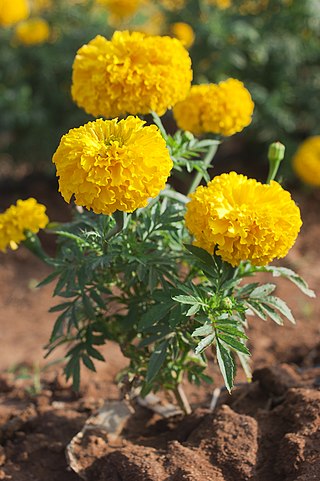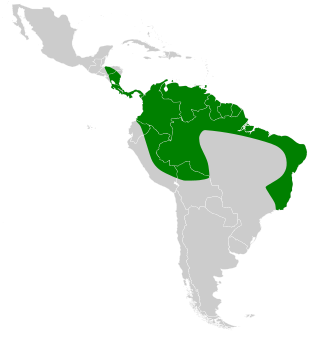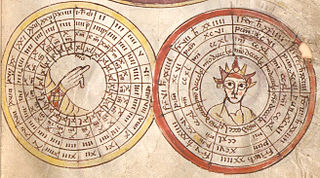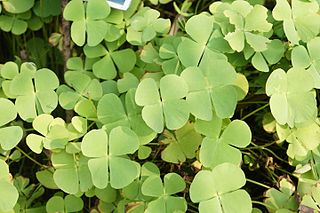
The minute is a unit of time usually equal to 1/60 of an hour, or 60 seconds. In the UTC time standard, a minute on rare occasions has 61 seconds, a consequence of leap seconds. Although not an SI unit, the minute is accepted for use with SI units. The SI symbol for minute or minutes is min. The prime symbol is also sometimes used informally to denote minutes of time.

The little stint, is a very small wader. It breeds in arctic Europe and Asia, and is a long-distance migrant, wintering south to Africa and south Asia. It occasionally is a vagrant to North America and to Australia. The genus name is from Ancient Greek kalidris or skalidris, a term used by Aristotle for some grey-coloured waterside birds. The specific minuta is Latin for "small.

Tagetes is a genus of annual or perennial, mostly herbaceous plants in the family Asteraceae. They are among several groups of plants known in English as marigolds. The genus Tagetes was described by Carl Linnaeus in 1753.
Gobipteryx is a genus of prehistoric bird from the Campanian Age of the Late Cretaceous Period. It is not known to have any direct descendants. Like the rest of the enantiornithes clade, Gobipteryx is thought to have gone extinct near the end of the Cretaceous.

The white-bellied big-eared bat is a bat species from South and Central America, as well as Trinidad and Tobago in the Caribbean.

A moment (momentum) is a medieval unit of time. The movement of a shadow on a sundial covered 40 moments in a solar hour, a twelfth of the period between sunrise and sunset. The length of a solar hour depended on the length of the day, which, in turn, varied with the season. Although the length of a moment in modern seconds was therefore not fixed, on average, a moment corresponded to 90 seconds. A solar day can be divided into 24 hours of either equal or unequal lengths, the former being called natural or equinoctial, and the latter artificial. The hour was divided into 4 puncti (quarter-hours), 10 minuta, or 40 momenta.

Tagetes minuta is a tall upright marigold plant from the genus Tagetes, with small flowers, native to the southern half of South America. Since Spanish colonization, it has been introduced around the world, and has become naturalized in Europe, Asia, Australasia, North America, and Africa. Tagetes minuta has numerous local names that vary by region. In the Andes it is known as Huacatay or Wacatay, and in other regions it is common as chinchilla, chiquilla, chilca, zuico, suico, or anisillo. Other names include muster John Henry, southern marigold, khakibos, stinking roger, wild marigold, and black mint.
Coptosia is a genus of longhorn beetles of the subfamily Lamiinae, containing the following species:
Coptosia behen is a species of beetle in the family Cerambycidae. It was described by Sama and Rejzek in 1999. It is known from Turkey. It feeds on Centaurea urvillei.
Coptosia chehirensis is a species of beetle in the family Cerambycidae. It was described by Stephan von Breuning in 1943, originally under the genus Conizonia. It is known from Turkey.
Coptosia albovittigera is a species of beetle in the family Cerambycidae. It was described by Heyden in 1863, originally under the genus Phytoecia. It is known from North Macedonia, Greece, Bulgaria, and Turkey. It contains the varietas Coptosia albovittigera var. conjuncta.
Coptosia antoniae is a species of beetle in the family Cerambycidae. It was described by Edmund Reitter in 1889, originally under the genus Phytoecia. It contains the varietas Coptosia antoniae var. uniformis.
Coptosia bithynensis is a species of beetle in the family Cerambycidae. It was described by Ganglbauer in 1884, originally under the genus Phytoecia. It is known from Bulgaria, Turkey, Armenia, and possibly Romania.
Coptosia brunnerae is a species of beetle in the family Cerambycidae. It was described by Sama in 2000. It is known from Jordan.
Coptosia compacta is a species of beetle in the family Cerambycidae. It was described by Édouard Ménétries in 1832, originally under the genus Saperda. It is known from Israel, Iran, Syria, Armenia, Jordan, and Turkey.
Coptosia demelti is a species of beetle in the family Cerambycidae. It was described by Stephan von Breuning in 1973.
Coptosia nigrosuturata is a species of beetle in the family Cerambycidae. It was described by Leopold Heyrovský in 1950. It is known from Israel.
Coptosia schuberti is a species of beetle in the family Cerambycidae. It was described by Ernst Fuchs in 1965. It is known from Turkey.
Coptosia tauricola is a species of beetle in the family Cerambycidae. It was described by Stephan von Breuning in 1943.

Marsilea minuta, or dwarf waterclover is a species of aquatic fern in the family Marsileaceae. It is not to be confused with Marsilea minutaE.Fourn. 1880, which is a synonym for Marsilea vestita. Other common names include gelid waterklawer, small water clover, airy pepperwort, and pepperwort, though the lattermost also applies to plants in the genus Lepidium. In French it is called marsilea à quatre feuilles and petite marsilée, the latter appearing to be a calque with the Latin botanical name. In Chinese it is 南国田字草, literally "southern field word grass," referencing the similarity of the leaflet shape to the Chinese character for "field." The Koch Rajbongshi people and Garo people call it shusni shak. It is called 'শুশনি শাক' in Bengali. In parts of India it can be called sunisanakka In Indonesian it is semanggi, but this name also applies to Marsilea crenata. In Japanese it is nangokudenjiso and in Thai it is phakwaen. In Malaysian it is tapak itek. In the Philippines it is kaya-kayapuan.






